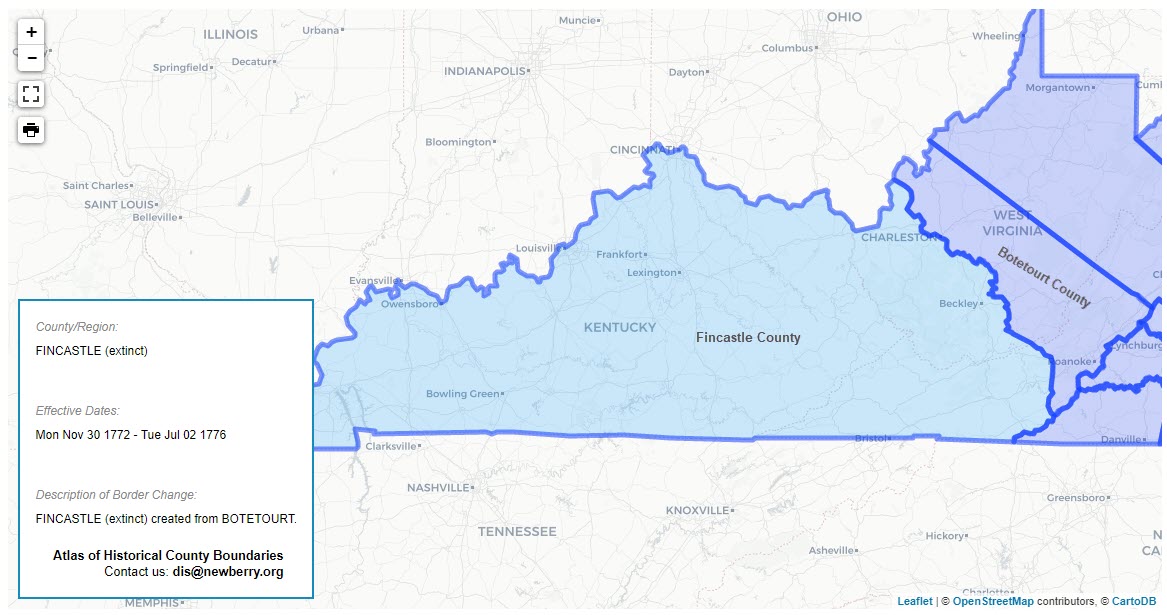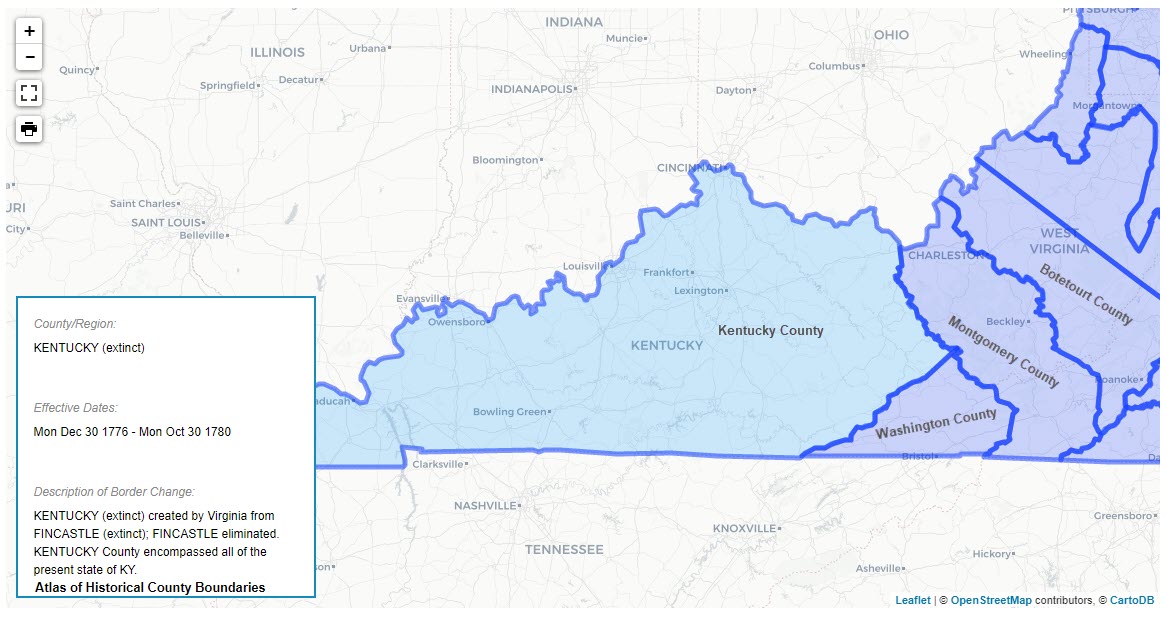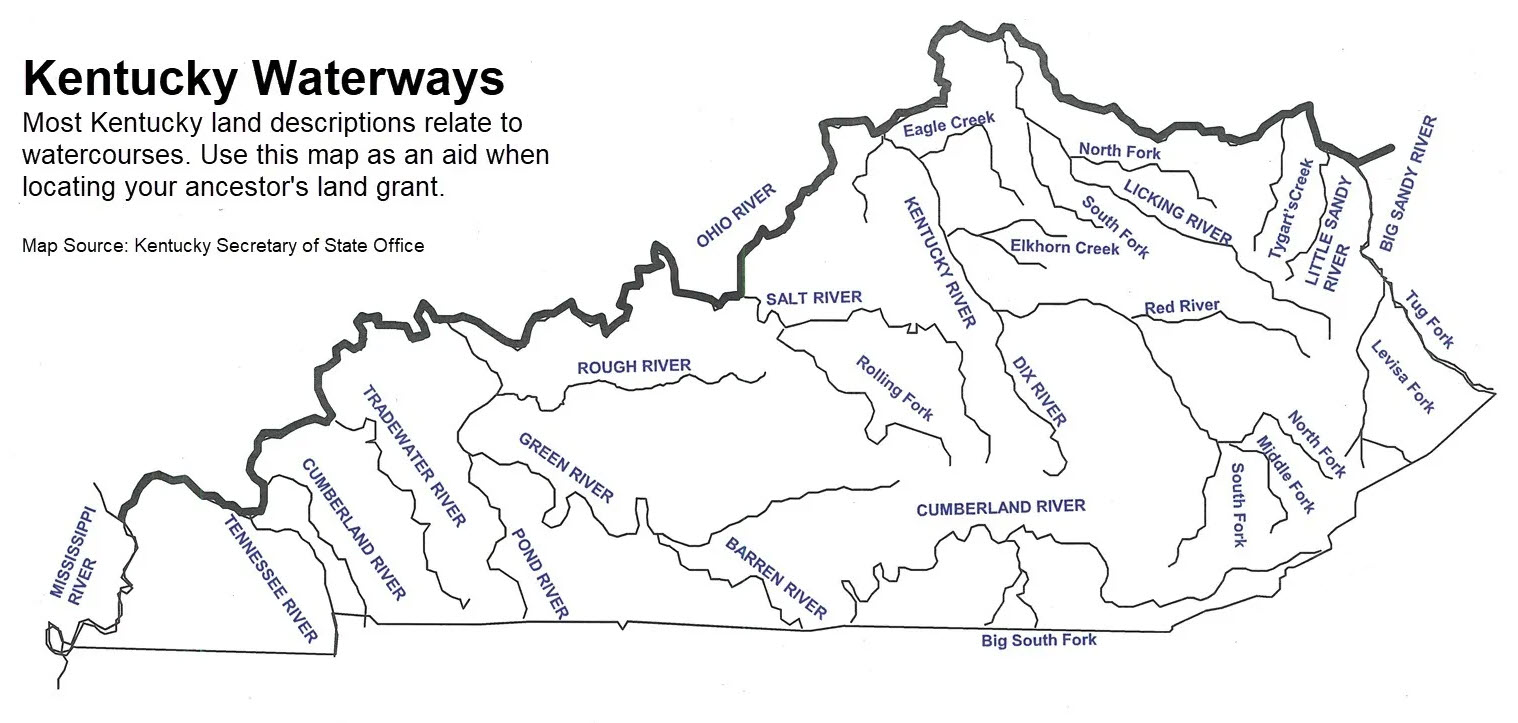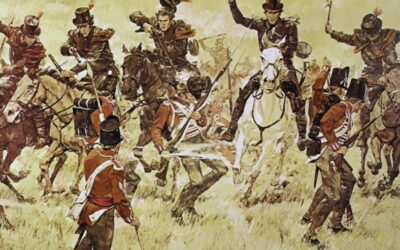Most Kentucky genealogists know Kentucky was once a part of Fincastle County, Virginia. Many may have wondered if there are any records from Fincastle County and, if so, where they are kept. We have found some answers to those questions on a November trip through western Virginia.
The Doomed Fincastle County
Virginia was first settled by the Virginia Company of London. The company’s 1609 charter gave it the land “200 miles north and south of Point Comfort from sea to sea, west and northwest.” But it was a long time before Virginia gave much attention to the land west of the Blue Ridge.
In fact, by the proclamation of 1763 by King George III, moving beyond the Appalachians was forbidden. All the land between Florida and Quebec was reserved for the Native Americans. Despite the proclamation, land-hungry Virginians looked to the west.
The first attempt to establish Virginia authority over the Western Waters was in 1745, when Augusta County was established out of Orange County. Augusta County included all the territory beyond the Blue Ridge mountains claimed by the British. Pittsburgh was the seat of Augusta a few times.
In 1769, they cut Botetourt County from Augusta County and included the western territory. Its county seat was the town of Fincastle. Then, in 1772, they divided Botetourt to create Fincastle County. Its county seat was a place called Lead Mines (now Austinville in Wythe County).

Fincastle County, Virginia. Atlas of Historical County Boundaries Newberry Library (Chicago)
Fincastle County, Virginia, was named after the town of Fincastle, which was the county seat. The town of Fincastle was established in 1772 and named in honor of Lord Fincastle, who was the eldest son of the governor of Virginia at the time, Lord Dunmore.
Lord Dunmore was a Scottish aristocrat who was appointed governor of Virginia in 1771. He was known for his support of the British crown and his opposition to American independence, which eventually led to his removal from office and exile to England in 1775.
Despite Lord Dunmore’s controversial tenure as governor, the town of Fincastle and Fincastle County retained their names after the American Revolution. The town of Fincastle remains today as a historic landmark in Botetourt County, Virginia, and is known for its well-preserved 18th-century architecture and charming small-town atmosphere.
Virginians Pushed Westward
Meanwhile, Virginians and North Carolinians had been pushing to the west. Permanent settlement began in Kentucky in 1774 and more settlers followed. But the Virginia government gave them little protection from Native American retaliation.
On 6 June 1776, George Rogers Clark called a meeting at Harrodstown (today’s Harrodsburg) to discuss the western situation. They elected Clark and Gabriel Jones as representatives to the Virginia Assembly. Their goal was to request Virginia help protect the West.
Clark succeeded in getting an order for 500 pounds of gunpowder and persuaded the Assembly to create Kentucky County out of Fincastle. This was on 31 December 1776. This ended Kentucky’s involvement in Fincastle, but some records in Fincastle concerned land and people in Kentucky, as well as the area that remained in Virginia.
In 1777, Fincastle County ceased to exist, its territory being used to create Kentucky County, Washington County, and Montgomery County. The Fincastle records went to Montgomery County, which are now housed in the courthouse at Christiansburg, Virginia.

Kentucky County, Virginia. Atlas of Historical County Boundaries Newberry Library (Chicago)
Finding Fincastle County on a Map
The present Virginia counties of Montgomery, Washington, Wythe, Grayson, Carroll, Tazewell, Buchanan, Giles, Bland, Floyd, Smythe, Wise, and Dickenson came wholly or in part from Fincastle. So, you see, there are many families whose records might be in the Fincastle papers.
There is one problem in using the Fincastle deeds. Most are identified as to location only by the waters on which the land lay. So, if it refers to New River, Holston, or Clinch, it was in Virginia. If it refers to Kentucky River, Elkhorn or Stoner Creek, or Salt River, it was likely in Kentucky.

Kentucky Waterways
What Records Exist
Mary Kegley, an attorney in Wytheville, has been researching history and genealogy for over twenty years. She has written or co-authored several books and writes a regular newspaper column. She has done considerable research in Fincastle records in Montgomery County. On our recent visit with her at Wytheville, she told us that the records there include:
- Fincastle Deed Book One
- Survey Records and Plats
- Court Order Books
- A few wills
- A few, very few, marriages. There was probably no one in the Fincastle area to perform marriages according to Anglican law.
These records include two types of material of interest to Kentucky researchers:
- Records about people and land in the part of Fincastle that later became Kentucky.
- Records about persons who were in the Fincastle area still in Virginia. Many of these later came to Kentucky. Some of these later became prominent citizens in the new state.
During its brief history, Fincastle included (besides Kentucky) much of southwestern Virginia and southern West Virginia.
Finding the Fincastle Records
Among the books Mary Kegley has published are Early Adventurers on The Western Waters (multiple volumes) and Glimpses Of Wythe County, Virginia. The latter book includes a list of tithables for 1770-1773, which gives the names of most of the early settlers in southwest Virginia.
In 1987, Michael L. Cook published material from the Fincastle records in the Fincastle and Kentucky, VA-KY Records and History. The book contains:
- Record of Surveys
- Deed Book A, 1773 (Abstracts)
- Deed and Will Book B, 1773 (Abstracts)
- County Court Order Book No. 1, 1773
- County Court Order Book No. 2, 1774-1776
Cook’s book also includes legislative acts concerning Fincastle County and Kentucky County.
The creation of Kentucky County from Fincastle County, Virginia, was a pivotal moment in our history that marked the beginning of a new era for the region. Today, Kentucky remains a vibrant and culturally rich state that owes much of its heritage to its origins as a part of Fincastle County, Virginia.
Resources
- Library of Virginia, Fincastle County Resources
- FamilySearch, Montgomery County, Virginia
- Genealogy Trail History Group, Fincastle County Coverage





